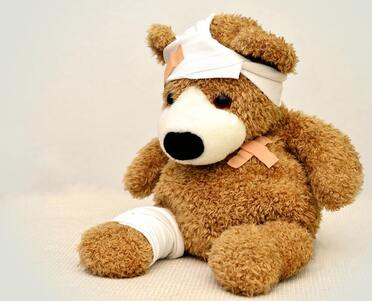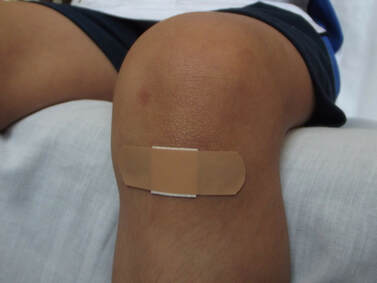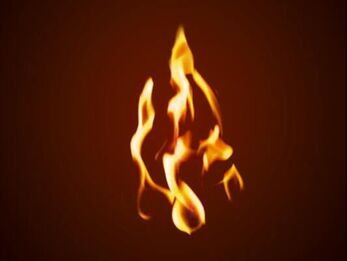|
Sooner or later, every child will fall and strike his or her head. Falls are especially common when your child is learning to walk. Most head injuries simply result in a scalp injury. Big bumps can occur with minor injuries because the blood supply to the scalp is so plentiful. For the same reason, small cuts on the scalp or face can bleed profusely.
Home Care Steps: 1) If there is a scrape, wash it off with soap and water. 2) Apply pressure with a clean cloth for 10 minutes to stop any bleeding. 3) For swelling, apply ice for 20 minutes. (Frozen vegetables such as peas work well or keep a wet sponge in a zippered bag in the freezer). For more serious head injuries, look for the following symptoms:
Call our office immediately if:
Comments
A bump or bruise may cause damage to superficial blood vessels, resulting in a black and blue mark. Since the skin is not broken, there is no risk of infection. Bruises usually follow injury caused by blunt objects.
Unexplained bruises may indicate a bleeding tendency. However, unexplained bruises overlying the shins are usually not a sign of a bleeding tendency. Children often bump this area and then forget about it. Home Care Steps: 1) Apply ice to the bruised area for 20-30 minutes. 2) No other treatment should be necessary. Optional: Give acetaminophen (Tylenol) or Ibuprofen (Motrin) for pain relief. Avoid aspirin. Bruises usually resolve in about 2 weeks. During this time, the color will change from blue to green to yellow. Note: If a blood blister is present do not open it due to increased risk of infection. It will dry up and peel off in 1-2 weeks. Call our office immediately if:
These wounds occur when the skin has been completely punctured by an object that is narrow and sharp, such as a nail. Since puncture wounds usually seal over quickly, there is a greater chance of wound infection.
Home Care Steps: 1) Soak the wound in warm water and soap for 15 minutes. 2) Scrub the wound with a washcloth to remove any debris. 3) Cut off any flaps of loose skin that cover the wound and interfere with drainage or removing debris. 4) Apply an antibiotic ointment and a bandaid to reduce the risk of infection. 5) Re-soak the area and reapply antibiotic ointment every 12 hours for 2 days. 6) Give acetaminophen (Tylenol) or Ibuprofen (Motrin) for pain relief. Call our office immediately if:
An abrasion is an area of superficial skin that has been scraped off during a fall, such as a skinned knee. Wash the wound for at least 5 minutes with warm water and soap. The area will probably need to be gently scrubbed several times to get out all the dirt. You may have to remove some dirt particles with a pair of tweezers. Pieces of loose skin may be cut off with clean scissors. Apply an antibiotic ointment and cover the scrape with a bandaid or gauze dressing. Cleanse the area once a day with warm water and then reapply the ointment and dressing until the scrape is healed. Give acetaminophen (Tylenol) or Ibuprofen (Motrin) for pain relief.
Call our office immediately if:
Be careful with pots, warm air humidifiers, cooking on the stove, hot cups of coffee and soup on the table, matches, fireplaces and of course electrical outlets. Be aware that exposed surfaces of ovens and radiators are sometimes hot enough to cause burns.
First-degree burns are mild and result in redness, slight swelling, and pain. Sunburns are usually first-degree burns. Second-degree burns cause blistering and more intense swelling and pain. Third-degree burns are serious and life threatening, causing charring and destruction of all the skin layers. Usually you can treat a first-degree burn yourself by soaking the burned area in cool water for 10 minutes. Keep it clean, dry and free from sun exposure until it heals. Second-degree burns require our attention, particularly if they occur on the face, hands or feet. First, soak the burned area in cold water. When you bring your child to the office, cover the burn with sterile gauze or a clean cloth (not absorbent cotton). Try not to pop the blisters. Give acetaminophen (Tylenol) or ibuprofen (Motrin) for pain relief. Third-degree (full-thickness) burns require emergency treatment at the nearest hospital. Call 911 immediately. [HOW DO YOU KNOW IF IT'S 1st/2nd/3rd DEGREE?] |
AuthorThe staff of Panda Pediatrics, located in Washington, D.C. Categories
All
Archives |
|
Schedule your visit today!
|
HOURSMon: 9am-5pm
Tues: 9am-5pm Wed: 9am-5pm Thurs: 9am-5pm Fri: 9am-2pm Closed daily 12pm-1pm. |
Phone: 202-466-5350
Fax: 202-466-8555 After Hours: 703-535-1856 Email: info@pandaped.com Billing: 1-888-969-3735, option# 1 |
ADDRESS2440 M Street NW
Suite #422 Washington, DC 20037 POLICIES |





 RSS Feed
RSS Feed

